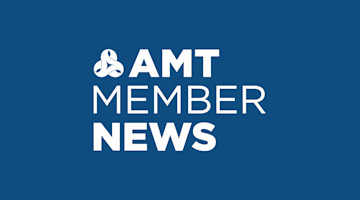What is keeping many small, medium, and large manufacturers from adopting smart digital manufacturing technologies? Is it a general reluctance to change in the context of dealing with day-to-day supply chain issues, uncertainty about the return on investment when bringing in new technologies, equipment, and processes, or a general lack of knowledge about new and emerging technologies? It’s all those reasons and more, as well as workforce development – or, rather, the lack of available workers across existing job functions, not to mention for new jobs brought on by new technologies, which plays a major role in decisions about technology adoption.
AMT – The Association For Manufacturing’s mission on behalf of our members is to advance emerging and transformational technologies. Part of that mission surrounds workforce development, or what we’ve referred to as “Smartforce Development” for more than the past decade.
The AMT Manufacturing Mandate
Recently, the Advocacy group at AMT published an update to the Manufacturing Mandate. This document is directed to Capitol Hill because it demands national attention and is designed to put forth our industry’s vision of a solution set to advance the cause of U.S. manufacturing on the global stage.
The three key pillars of the AMT Manufacturing Mandate include recommendations around harnessing the power of manufacturing technology to spur innovation; injecting predictability and stability into tax, trade, and regulatory systems; and transforming the workforce into a Smartforce that is skilled in manufacturing technologies.
Smartforce Recommendations
Where Smartforce Development is concerned, we have made these key recommendations in the Manufacturing Mandate:
Develop federal policies that encourage the hiring of additional career and technical education (CTE) teachers.
Develop federal policies that incentivize schools to purchase manufacturing technology equipment for high school, community college, and engineering school programs.
Improve perceptions of careers in manufacturing that will incentivize families to consider dual credit programs and “earn-and-learn” apprenticeships as a method for reducing dependence on student loans.
Increase the adoption of smart industry-recognized standards and credentials using a central repository to track digital badges, microcredentials, certificates, and degrees using blockchain-type technology that provides companies with a method of finding workers on demand who possess the transformational technology competencies that are in demand.
Industry Advisory Councils
We have consistently advocated for AMT members to be active on industry advisory councils in schools in your local area, and we hope that you will advocate for our policy recommendations at the local, state, and federal levels. Doing so is particularly important now, as schools have been disrupted over the past couple of years, resulting in an even greater skills gap that our industry, along with most every other industry in the country, is challenged in overcoming.
To that end, we are seeing that more and more manufacturers are hiring for cultural fit, as compared to simply recruiting and hiring for specific skills and competencies, since the gap is so large between our industry’s open positions and the number of qualified people coming out of technical school programs. That thinking is clear-minded. Cultural fit can outweigh knowledge and experience if your company is adept at on-the-job training.
On-the-Job Training
If you are not as adept at on-the-job training (OJT) – and most employers are not, despite what they might think about their training programs – NIMS can help. AMT has been an industry stakeholder in NIMS since its inception more than 27 years ago. NIMS is best known for developing industry-recognized standards and credentials for CNC operators, as well as for job skills like measurement, materials, and safety. NIMS has recently completed a five-year strategic plan to develop industry-recognized standards and credentials for duty areas like additive manufacturing, quality inspector, industrial technology maintenance, and smart production specialists to support the adoption of smart digital manufacturing.
For improving OJT at your company, NIMS has also developed Smart Training Solutions (STS), an innovative framework for modernizing training that enables manufacturers to train the trainer at your company to provide on-the-job training to your employees, as well as to continually update your training methods to account for changes in job duties brought about by the adoption of emerging technologies and equipment.
GDT: An Example of Improving Your OJT
In 2001 when I was part of the executive team that launched ToolingU, we discovered that nearly every company and every trade school needed a better way to train on the subject of geometric dimensioning and tolerancing (GDT). This included content. In speaking with the team at ToolingU/SME recently, I’ve learned that GDT and safety classes are still among the most popular courses used by ToolingU/SME customers.
GDT is an international standard with symbols that describe parts in a language that is clearly understood by manufacturers. This language is mathematical in nature and requires a unique set of knowledge and skills to interpret and apply in the workplace.
"Most companies, as well as teachers at educational institutions, struggle with learning and transferring GDT knowledge and skills. This is the result of not recognizing that GDT is a language." – Montez King, Executive Director, NIMS
According to Montez King, executive director at NIMS, “Most companies, as well as teachers at educational institutions, struggle with learning and transferring GDT knowledge and skills. This is the result of not recognizing that GDT is a language. Consider how we learned our native language. We learned without effort or formal teaching. The acquisition of our first language just happens through interaction.”
King continued: “Now consider the challenges of learning a second language. We think in our native language to understand how to interpret and speak in other languages. This reality is a major reason why most organizations struggle with GDT.”
NIMS’ GDT training will show your team how to make GDT your first language.
Retaining the Knowledge of Your Legacy Employees
Smart Training Solutions and OJT at your company will not only allow you to keep pace as emerging technologies change the landscape of your shop, but they will allow you to retain the legacy knowledge of your existing workforce even as the current generation of your workers retire at an ever-increasing rate.
To find out more about Smart Training Solutions from NIMS, visit nims-skills.org.
Contributions to this article were made by Catherine Ross, director of education, AMT. If you have any questions about this information, or want to learn more about Smartforce Development Strategies, please contact Greg at gjones@AMTonline.org or Catherine at cross@AMTonline.org.






